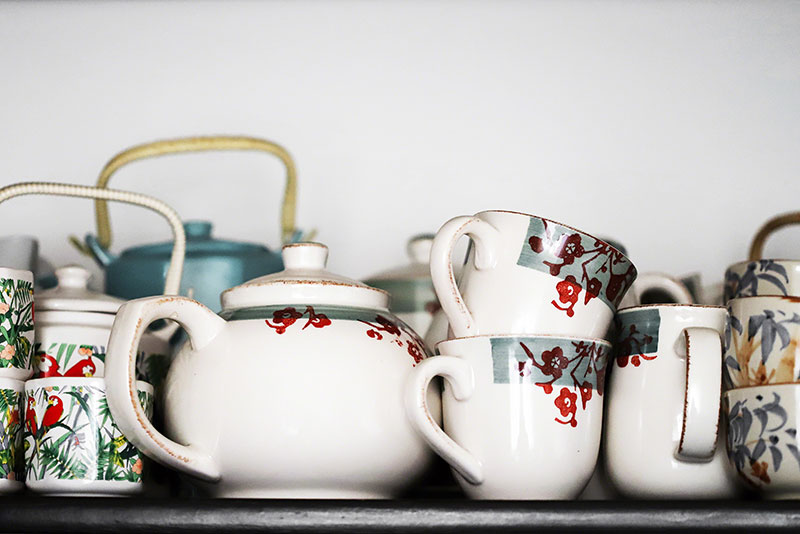Every good tea needs a good teaware, and good teaware can be quite expensive. As you learn more about tea, a single mug might not be enough not be enough to satisfy all your needs. Nowadays, buying new teaware is easier that ever. But, is it always safe? Read our short guide on how to avoid dangerous teaware.

(Source: Tea Bespoke ©)
How to recognize dangerous teaware?
Tea lovers don’t only have a habit of collecting tea, they also have an addiction to collect teaware. If you are interested in traditional eastern teaware, Kyusu teapots or Chinese yixing teapots and cups can carry a high price tag. You might want to search for more affordable pieces, even buy those with the price too good to be true. And that’s when most of the danger will probably lurk from. Some teaware can pose a direct danger because it is made of toxic materials. However, some accidents are not the fault of the product itself. For example, burns are likely to occur when using teaware that is difficult to use.
Dangerous or not?
Let’s explore some of teaware you are likely to use if you are an avid tea drinker.
1. Gaiwans
Gaiwan is a Chinese tea vessel used for brewing tea. Once you get a grip, you can use it for brewing almost any loose leaf tea. If you are a beginner, you should pay attention to two things.
- Avoid buying cheap gaiwans as they might be of an inferior quality and more difficult to use, increasing the chance of getting burned.
- Avoid making black tea with boiling water using gaiwan until you get used holding it properly. Green tea is the best tea to start with.
Verdict: Gaiwans are more likely to cause burns than other teapots.
2. Houhin
This Japanese teapot has a lot in common with gaiwan, but are easier to use. The advantage is it is usually used for making tea that requires lower water temperature and has a small gap between the lid and a cup part.
Verdict: Likely to be safer than gaiwan for tea beginners.
3. „Antique“ teaware
Antique teaware bought for very low prices should be used only for display purposes. Antique looking cups or teapots might actually be quite new and cheap and made look dirty and „antique“ on purpose. The downside is that there is no way to know which paint, dirt or grease was used for making it look old and antique.
Verdict: Not recommended for brewing tea.
4. Yixing teaware
Chinese purple clay teapots are very expensive. Although even some expensive teapots might be fake, the danger lies in the unknown materials sold under the name of the pure purple clay. Yixing teaware may contain different coloring agents and might be made using processes that do not guarantee safe product. Authentic yixing teaware is generally unglazed and more likely to be very safe when bought from reputable producers.
Verdict: Cheap yixing teaware is not recommended for brewing tea.
5. Tetsubin
Authentic tetsubins are made of cast iron. As the popularity of Japanese tea and teaware started rising, the more of the less authentic tetsubins started appearing on the market. Those have an enamel coat inside, and cannot be used for boiling water. However, they can be used for brewing tea, even if the enamel has cracked. The only potential danger might come from eating a piece of enamel. Authentic tetsubins might be safer to boil water for tea than a kettle.
Verdict: Safe to use, but avoid extremely cheap tetsubins
6. Old second-hand teaware
It you like searching for your teaware on car boot sales and antique markets, you probably saw both good and bad teaware. If you plan to use your next purchase for brewing tea, remember to ask the seller in what conditions was it stored, where it was bought and how old it is. It will help you decide is it safe to use or not. Unglazed teaware might accumulate mold, and should better be avoided. Painted glazed teaware is easy to clean, but might contain colors that could be toxic, especially if it’s very old.
Verdict: We wouldn’t recommend using teaware that has a moldy smell or dirt that cannot be removed.
7. Plastic teaware
It seems that the more we get scared about using plastic, the more plastic there is in the world. Plastic is everywhere and is very likely somewhere inside your kettle. However, regardless of so much scary information about toxicity of plastic, there is still not enough evidence it can cause cancer. [1] Laws in the U.S. and Europe regulate the levels of chemicals that might leak from plastic. However, that law applies only to products bought in the U.S. and Europe, not to cheap products bought directly from manufacturer and shipped to U.S. and Europe to you as a buyer.
Verdict: We would avoid using plastic teaware mostly for aesthetic purposes and do not use plastic teaware and kettles from dubious sources.
What about other teaware?
Nowadays it’s very difficult to say which product is really safe, and which isn’t. Always trust your judgement first. Teaware that looks suspicious or was extremely cheap should probably be avoided. In the end, it pays to buy good teaware. You will be less likely to compromise your health and will enjoy your teatimes much more.
Disclaimer: This article is for guidance only. Every piece of teaware is different and without additional information it would be impossible to decide is it safe or dangerous.
[1] https://www.cancerresearchuk.org/about-cancer/causes-of-cancer/cancer-controversies/plastic-bottles-and-food-containers



Leave a Reply Cancel Reply